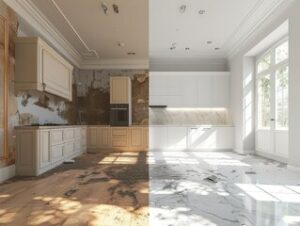Custom Drapes Near Me add style, eye-catching beauty, and privacy to your home while providing a high level of control over temperature. They can be used in any room, from formal living rooms to bedrooms.

Ready-made options are available in stores and online, and they are usually available for immediate purchase and installation. However, drapery designers do much more than sell a product.
Custom drapes are tailored to the exact specifications of your windows, ensuring a flawless fit and a refined look. They also offer a variety of customization options, such as header styles and pleat types, to help you create the look you’ve always wanted. From opulent velvet to airy linen and versatile cotton, you’ll find fabrics that reflect your style preferences, as well as your light control, privacy and insulation needs.
Ready-made drapery, on the other hand, is often produced in standard sizes and designs that aren’t suited to your space or aesthetic preferences. Plus, they may not be as hemmed or pleated as you’d like, and their lining may be a low-quality material that doesn’t provide the desired drapery look.
Choosing the right style of drapery for your space is important, as it adds character and demonstrates your personality. Do you want a classic pleated look, or something more casual with flat panels? Do you want to let in plenty of natural light, or do you prefer to block out the sun? Your drapery will also need to accommodate your lifestyle, as you’ll need to open and close them frequently.
Another benefit of custom drapery is that it provides a more luxurious feel to your home and can be paired with other window treatments, such as cellular shades or roller shades, for maximum energy efficiency. When layered with these other window treatments, your drapes will prevent heat and cooling transfer through the windows, making them more energy efficient.
To achieve a floor-length look, your drapes should extend from the top of the wall to about six inches above the flooring. This will ensure that your drapes don’t interfere with the opening and closing of doors, as well as allow for a fuller, more dramatic appearance.
Style Options
Custom drapes offer a range of design options that can be tailored to your personal preferences. You can choose the perfect fabric, color, pattern, pleat style, lining, and hardware, creating a unique look that enhances your decor. These luxurious window treatments can add dramatic flair to a room while offering privacy, light control, and insulation.
They also feature a longer lifespan than off-the-shelf options because they’re typically crafted with premium materials that withstand wear and tear better. They’re also sized to perfectly fit your windows, which can eliminate awkward gaps or puddling of fabric and ensures a more polished look.
Aside from the selection of fabrics, you can also customize the style of your drapes by choosing a header. Some popular choices include ripple fold, tailored, pinched, goblet, and grommet tops. Each one has its own unique appearance and functionality, but they all work well to complement the fabric you choose.
Drapery hardware is another great way to elevate your window treatment. The selection is vast, including everything from ornate finials to traversing hardware for large and tall windows. There are even motorized systems that can be used for larger windows.
Choosing the right drapes for your home will make all the difference in its overall look and feel. The right pair will accentuate your decor and elevate the look of any room. The options are endless, so take your time when selecting the ideal drapes for your space. You’ll be happy you did! If you need help choosing the perfect drapes for your home, contact a local window-treatment expert. They can connect you with a professional in your area who offers consultation, measurement, and installation services to guarantee a flawless final product.
Quality
Draperies add an elegant beauty to any room, from elongating windows in smaller rooms to enhancing formal dining areas. They can also help with energy efficiency and can be layered with many other window treatments, including blinds, shades, and valances. Unlike standard window treatments that can feel impersonal, custom drapery is designed to fit your space perfectly. It’s an investment that will pay off with a room that feels like your own.
In addition to their visual appeal, drapes can help with temperature control. Traditionally, they fall all the way to the floor or are hung a few inches above the floor, creating a layer of fabric that keeps temperatures more stable than curtains do. This is why drapes are commonly used in bedrooms and living rooms.
Unlike ready-made drapes, which are limited to a predetermined range of sizes and designs, custom drapery offers a wide selection of fabrics to complement your decor. You can also customize your drapes with features such as linings, trims, and header styles. These details can make all the difference in how your drapes look and how well they fit.
Custom draperies are typically made of high-quality decorator fabrics, and the quality is apparent from the moment you pull them open. These beautiful materials are woven to be durable and can hold up against coastal weather conditions. They are crafted with higher thread counts and more luxurious depth and puddling, and they come in a variety of rich colors and patterns to create a cohesive, stylish look. In addition, drapes are methodically inspected for snags and color variations, so you can enjoy yours with confidence.
Durability
Custom drapes are tailored to fit your home’s specifications, and they can add a sense of grandeur and height to any space. They offer more customization options than ready-made drapes, including fabrics, colors, patterns, and textures that complement your decor. You can also choose to add features like blackout lining to block out street lights or early morning sunlight, motorization to integrate into your smart home system for added convenience, and intricate trim details that elevate your design.
Because custom drapes are crafted with superior quality materials and craftsmanship, they are also more durable than store-bought options. This durability means that your drapes will last longer and be less likely to fade or wear out over time. This can save you money in the long run by reducing your need for replacements and maintenance.
Durability is also affected by the fabric used for your drapes, so it’s important to consider what kind of use you anticipate your window treatments getting before selecting a fabric. For instance, a fabric that’s highly prone to wrinkling will require more frequent professional laundering, while a silk fabric may lose its luster after repeated exposure to sunlight.
Drapes can be paired with many other window treatment options, and valances are a great option to hide the hardware at the top of your drapes. They can also help keep your drapes neat and tidy by blocking out light that peeks through the top of your window treatment, and they can add a more traditional feel to your space.
Cost
Custom drapes are a stylish, eye-catching addition to any room. They add drama and elegance, while also offering privacy and insulation. Custom drapes are an ideal window treatment for formal living rooms, dining rooms, and bedrooms. However, they can also be used in more casual spaces such as kitchens and home offices. They are also a popular choice for open-concept homes.
Drapes are crafted from beautiful decorator fabrics with higher thread counts and more durable materials than curtains. They are available in a wide range of colors, textures, and patterns, giving you the opportunity to create an entirely new look. Custom drapes are a bit more expensive than ready-made window treatments, but they offer more beauty, functionality, and longevity.
Unlike ready-made drapery that is made in standard sizes, custom drapes are designed and tailored to the exact dimensions of your windows. This ensures a perfect fit and eliminates the need for constant adjustments. Custom drapery is also a more luxurious option than curtains. They are typically made from heavier fabrics that provide a more dramatic aesthetic. Additionally, custom drapes are often designed to pool onto the floor a few inches, providing extra privacy and insulation.
The cost of custom drapes varies based on fabric selection, design complexity, and customization options. The lead time for custom drapes can also vary depending on fabric availability and production schedules. However, the investment in custom drapes is well worth it. They are a luxurious addition to any room, and they offer beauty, privacy, and insulation that is unmatched by any other window treatment. Schedule an in-home consultation to discover how drapery can elevate your space and help you achieve your desired look.

